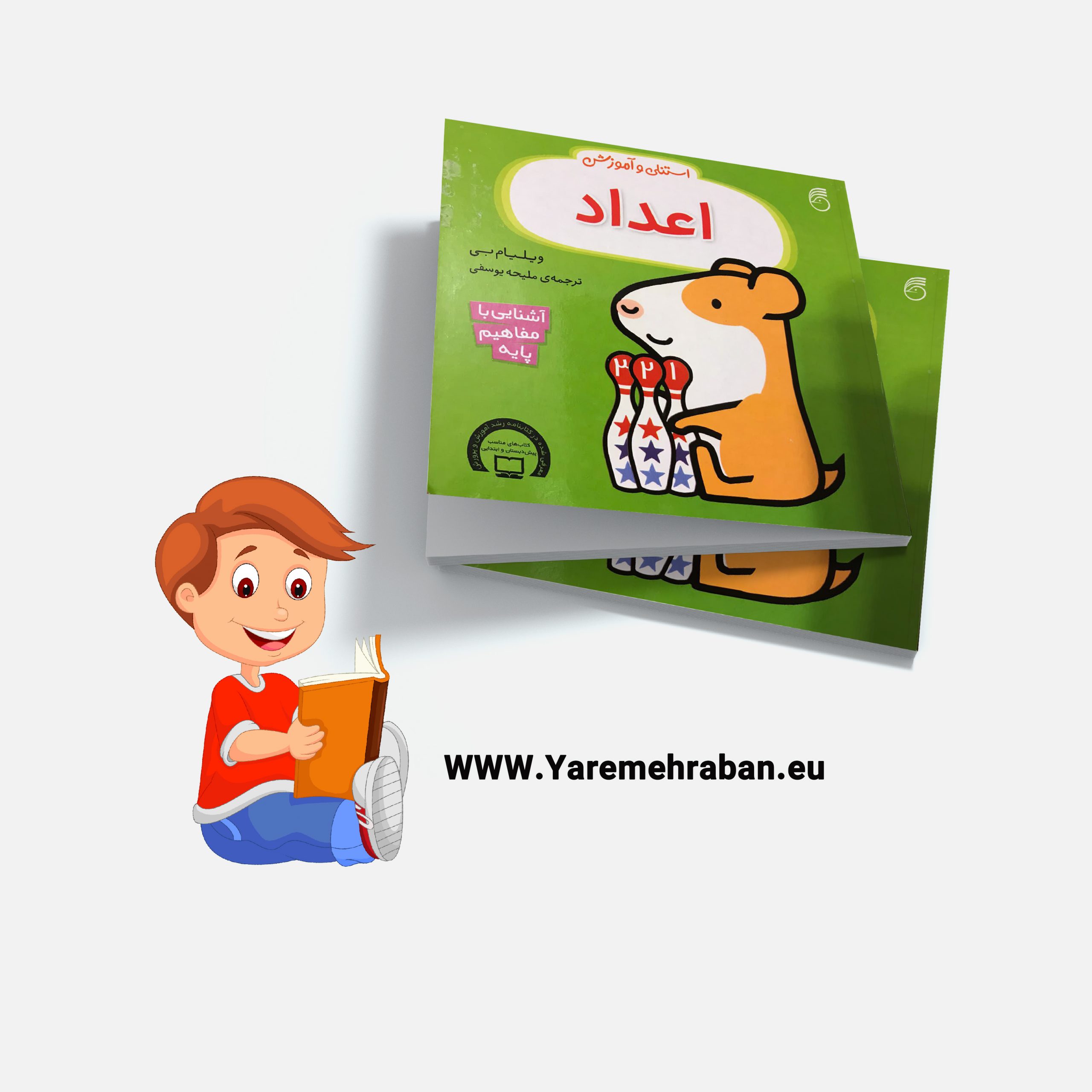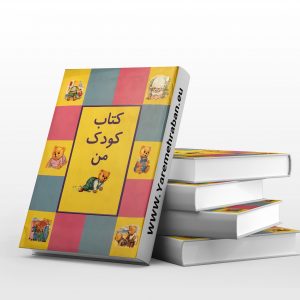Description
Stanley and the Teaching of Numbers is a work by William B., translated by Maliha Yousefi and published by Naria Publications. This book is suitable for preschool and elementary school children and teaches numbers from one to ten.
Stanley’s four-volume collection is a cardboard picture book in which two characters in the story, Stanley and Mousseau, introduce concepts such as shapes, colors, numbers, and contrasts in each volume.
In Stanley and Numbers, the concept of counting is taught to every child in a very simple way by introducing objects or foods.
This book is cardboard and with its simple and linear pictures, as well as bright colors, it is suitable for children from 1 to 3 years old, and in terms of teaching the concept of numbers from one to ten for children from 3 to 5 years old.
Part of the book:
Stanley has a jelly.
Little Musso has two cakes.
Stanley has three tubular carpets for travel.

About the author:
William B. (born: London, England) is a commercial artist and designer who has worked in famous fashion houses including Issy Miyaki and Paul Smith. In addition to writing children’s picture books and blackboards, he races in an old sports car, is an international skier, and maintains his lawns and meadows when he is at home. He lives in England.
What is the best way to teach numbers to preschool children?
To teach numbers to children, it is good to use picture books, games, objects and teaching aids for children. You need to spend a lot of time learning each number.
Understanding numbers plays a very important role in our daily lives. Children in preschool and elementary school begin to learn numbers and work with them; A very important training that prepares them for more complex math practices in the years to come.
Stanley’s four-volume collection includes the following books:
Stanley and color training
Stanley and teaching numbers
Stanley and teaching shapes
Stanley and Teaching Contradictions
With the help of this book, you can introduce children to counting from the age of two so that they do not face any problems when they enter school. This can be done in a variety of ways, including audio and video. Show the child that math is part of our daily lives and that he or she will eventually need to develop arithmetic and math skills for his or her daily tasks, and this should be done by the parents.
Be your child’s teacher with the help of Stanley’s book and number teaching:
1. Teach counting
In the first step, teach the child to count numbers from 1 to 10. Most children can easily memorize these ten numbers and learn to sing them like a piece of music. Practice this basic skill with them whenever you get the chance. Many children learn better when they use their sense of touch. Let the child touch objects and count. It helps to make sense of each number.
۲. Introduce numbers
To begin, write numbers from one to ten on pieces of paper. Read each issue aloud and point to them in order. This action connects the counting skill with the visual image of each number in the child’s mind. You can also use number cards. Raise a number and say its name aloud. Then ask the child to find the same number in his / her deck and repeat his / her name with you.
3. Talk about numbers
Start with the number 1 and make time for training for each one. Write each number in letters and numbers. Demonstrate the meaning of each number by pointing to an object, fingers, or any other device. Then go to the next issue and do the same. Try not to move on to the next numbers until you are sure the child fully understands them. It is better to master the numbers once and for all.
4. Get help from pictures
Many children learn better when they can visualize a concept. For each number, write the number on a piece of paper and show them a drawing that shows it. If you teach number 2, for example, draw two eyes, two apples or two flowers. For best results, you can ask your child to draw a related picture. You can still engage the sense of touch. Using beans, pencils or other tangible tools may help children understand these concepts. For example, in teaching number 3, give the child 3 pencils and let him understand it well.
5. Teach writing numbers
Show the child how to write numbers. When talking about a particular issue, teach your child how to write it. Let him try to write the number. Be creative and fun. For example, tell the child that he has a lean and flat body; A little play and fun have a huge impact on the process of educating children.
6. Practice ordering numbers
The sequence of numbers is very important. You can show this concept on one line; Write the numbers in order from left to right on a line and show that they are increasing. Ask the child to arrange the number cards correctly, or arrange them incorrectly yourself and ask the child to correct your mistake.
7. Learn the concept of “counting”
Once the child has learned the numbers and their sequence, it is time to learn how to count starting with any number, not just 1. Practice this concept with objects as well. For example, it is better to give the child numbers 5 to 10 and ask him to pick them. Even better, you can ask him to go for just two more digits. This concept will also help you learn to collect in the future.
1. play
Once you have taught the child the basics of numbers and counting, it is time to reinforce it so that it is not forgotten. There are countless ways to do this. For example, take some cubes and build towers with them. Or arrange them in steps; For example, first put one cube, then two cubes, then three cubes and finally together.
۲. Practice with music
There are children’s songs that you can use to help your child memorize numbers better.
3. Use picture books
There are many written resources for children to practice number writing. Prepare some of them and practice with the child.
4. Ask the child
Keep asking your child about numbers. Ask him to count things, such as how many pencils are on the table or how many plates you have. Or how many chocolates does he want?
5. Emphasize the concept of numbers
Play games with your child to help them understand the relationship between the committees and the corresponding numbers. For example, ask your child to count a certain number of beans, then ask them to add or subtract another number. Ask him out well if he is no longer absorbed in the connection.
6. Teach comparing numbers
Explain to the child that some numbers are smaller and some are larger than others; For example, 1 is less than 10. Using beans, pencil, sugar or any other object, make two groups and put a certain number of that object in each group. Ask the child to tell you which group is bigger than the other.
Related books
Rapunzel’s book falls into the age group A and B.
Audiobooks for children and lullabies of kind friend on YouTube:
1- Childish audio lullaby on YouTube
2- The childish audio story of Ali Chicken on YouTube
3. The childish audio story of the red cape on YouTube
4- Audio children’s story of two brothers on YouTube
5- Hassan Kachel children’s audio story on YouTube
6- The audio story of Aunt Beetle’s wedding audio on YouTube
Audiobooks for children and lullabies of kind friends in Aparat:
7- Childish audio lullaby in the device
8- The childish audio story of Ali Chicken in Aparat
9- The childish audio story of the red cape in Aparat
10- Children’s audio story of two brothers in Aparat
11- Hassan Kachel children’s audio story in Aparat
12- The childish audio story of Aunt Suske’s wedding in Aparat
My dear friend’s recommended baby book:
1- Hassani astronaut
2. Coloring birds
3- Snow white
4- Rapunzel
5. City of Mice
6. Ancient stories
7- Little Prince
8- Smart fox
9- The wizard of the city from
10- Jack and the magic beans
1- Introducing the book on YouTube
2- Introducing the book in Aparat



Reviews
There are no reviews yet.